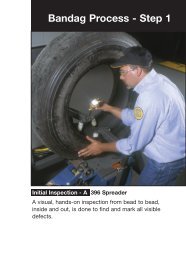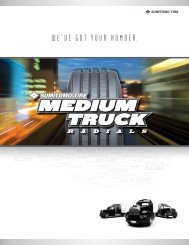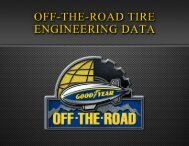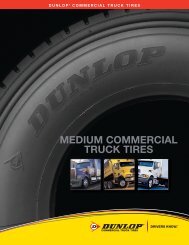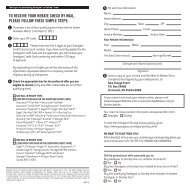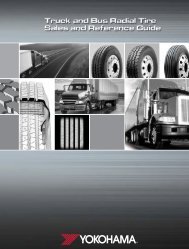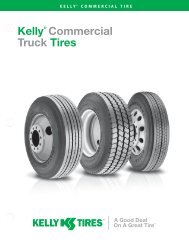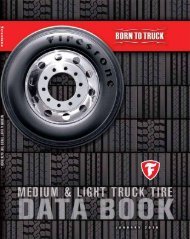Bridgestone Medium and Light Truck Tire Data Book - Sullivan Tire ...
Bridgestone Medium and Light Truck Tire Data Book - Sullivan Tire ...
Bridgestone Medium and Light Truck Tire Data Book - Sullivan Tire ...
You also want an ePaper? Increase the reach of your titles
YUMPU automatically turns print PDFs into web optimized ePapers that Google loves.
Effective January 2010<br />
addition, have your tires periodically evaluated by a<br />
qualified tire service professional when your vehicle<br />
is serviced such as routine maintenance intervals,<br />
oil changes, <strong>and</strong> tire rotations. In particular, note the<br />
following tips for spotting tire damage:<br />
• After striking anything unusual in the roadway,<br />
have a qualified tire service professional demount<br />
the tire <strong>and</strong> inspect it for damage. A tire may not<br />
have visible signs of damage on the tire surface.<br />
Yet, the tire may suddenly fail without warning, a<br />
day, a week, or even months later.<br />
• Inspect your tires for cuts, cracks, splits or<br />
bruises in the tread <strong>and</strong> sidewall areas. Bumps<br />
or bulges may indicate a separation within the<br />
tire body. Have your tire inspected by a qualified<br />
tire service professional. It may be necessary<br />
to have it removed from the rim/wheel for a<br />
complete inspection. Do not delay performing any<br />
necessary repair(s).<br />
• Inspect your tires for adequate tread depth.<br />
When the tire is worn to the built-in indicators<br />
at 2/32 inch (1.6 mm) or less tread groove<br />
depth, or the tire cord or fabric is exposed, the<br />
tire is dangerously worn <strong>and</strong> must be replaced<br />
immediately.<br />
• Federal regulations require steer axle tires to<br />
have 4/32 inch (3.2 mm) or greater tread depth on<br />
vehicles over 10,000 lbs (4536 kg) GVWR.<br />
SAFETY WARNING<br />
Driving on an improperly repaired tire is dangerous.<br />
An improper repair can be unreliable or permit<br />
further damage to the tire. The tire may suddenly fail,<br />
causing serious personal injury or death. A complete<br />
inspection <strong>and</strong> repair of your tire in accordance<br />
with Rubber Manufacturers Association (RMA)<br />
procedures should be conducted by a qualified tire<br />
service professional.<br />
The comprehensive procedures <strong>and</strong><br />
recommendations for truck tire repair are beyond the<br />
scope of this manual; however, note the following:<br />
• The tire must be demounted from the rim/wheel<br />
for a complete inspection, inside <strong>and</strong> out. Some<br />
damage to the tire may only be evident on the<br />
interior of the tire. Any tire repair done without<br />
removing the tire from the rim/wheel is improper.<br />
• A patch must be applied to the interior of the tire<br />
<strong>and</strong> the puncture hole filled with suitable plug/<br />
stem filler. This helps ensure that the interior of<br />
the tire is adequately sealed to prevent inflation<br />
pressure loss <strong>and</strong> prevents contamination of the<br />
steel belts <strong>and</strong> other plies from the elements (such<br />
TIRE REPAIRS<br />
General Technical Information<br />
• Inspect your tires for uneven wear. Wear on one<br />
side of the tread or flat spots in the tread may<br />
indicate a problem with the tire or vehicle. Consult<br />
a qualified tire service professional.<br />
• Inspect your rims/wheels also. If you have a<br />
bent, chipped, or cracked rim/wheel, it must be<br />
replaced.<br />
TIRE MANUFACTURE DATE<br />
The tire manufacture date is determined by examining<br />
the DOT tire identification number, also known as the<br />
DOT serial number or code, which can be found on<br />
at least one sidewall near the rim/wheel. It may be<br />
necessary to look on both sides of the tire to find the<br />
entire serial code.<br />
<strong>Tire</strong>s Produced Since 2000: The last four (4) digits<br />
of the serial code identify the week <strong>and</strong> year of<br />
production. For example, a tire with a serial code<br />
ending in “2406” would have been produced in the<br />
24th week of 2006.<br />
<strong>Tire</strong>s Produced Prior to 2000: The last three (3) digits<br />
of the serial code identify the week <strong>and</strong> year of<br />
production. For example, a tire with a code ending in<br />
“329” would likely have been produced in the 32nd<br />
week of 1999, but possibly produced in 1989. If in<br />
doubt, consult a qualified tire service professional.<br />
as water) in the outside world. Using only a<br />
plug/stem, or using only a patch, is not a safe or<br />
proper repair.<br />
• The truck/bus tire puncture repair injury limit to<br />
the tread area is 3/8 inch (10 mm). Larger injuries,<br />
or damage in areas outside the tread, should be<br />
evaluated <strong>and</strong> repaired, if possible, by qualified<br />
tire service professionals at a full-service repair<br />
facility using RMA-approved procedures.<br />
• Never substitute a tube for a proper repair or to<br />
remedy an improper repair.<br />
• Not all punctured or damaged tires can be<br />
properly repaired; consequently, they must<br />
be replaced.<br />
• Repair <strong>and</strong> retread, if possible, tires having a tread<br />
depth of 2/32 inch (1.6 mm) or less remaining in<br />
any tread groove.<br />
• Tubes, like tires, should only be repaired by a<br />
qualified tire service professional.<br />
• Any Improper repair voids the tire Limited<br />
Warranty. See “Limited Warranty” in this manual.<br />
<strong>Medium</strong> <strong>Truck</strong> <strong>Light</strong> <strong>Truck</strong> General Technical Load/Inflation Technical Bulletins<br />
65



